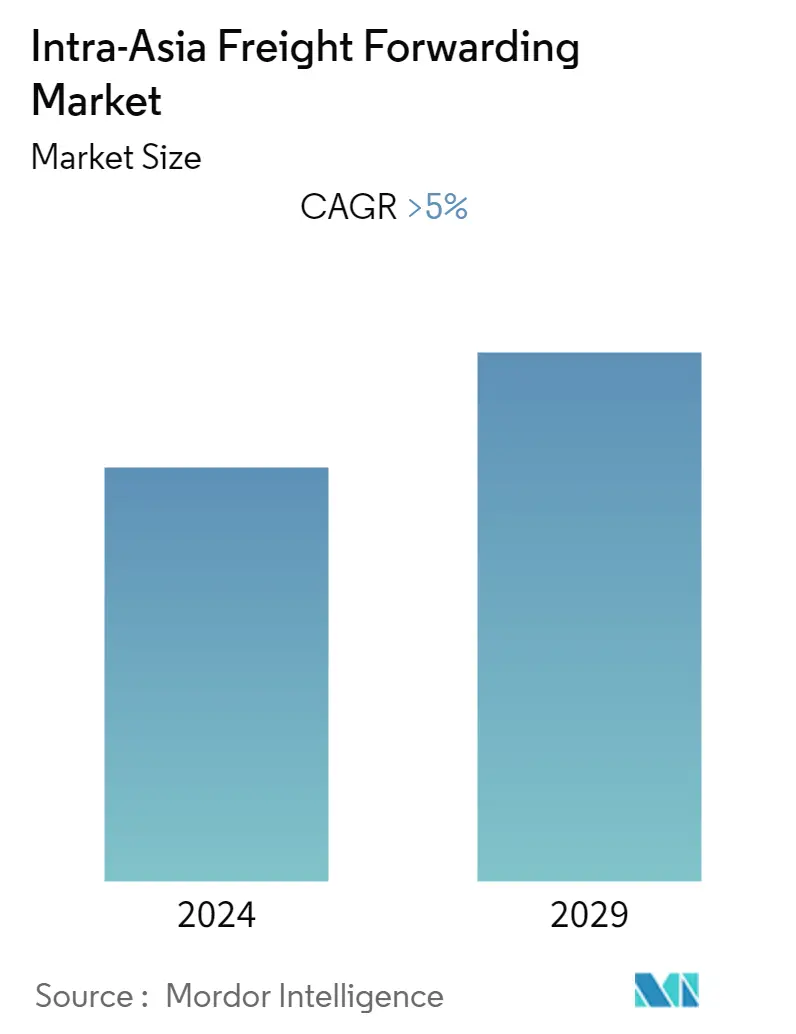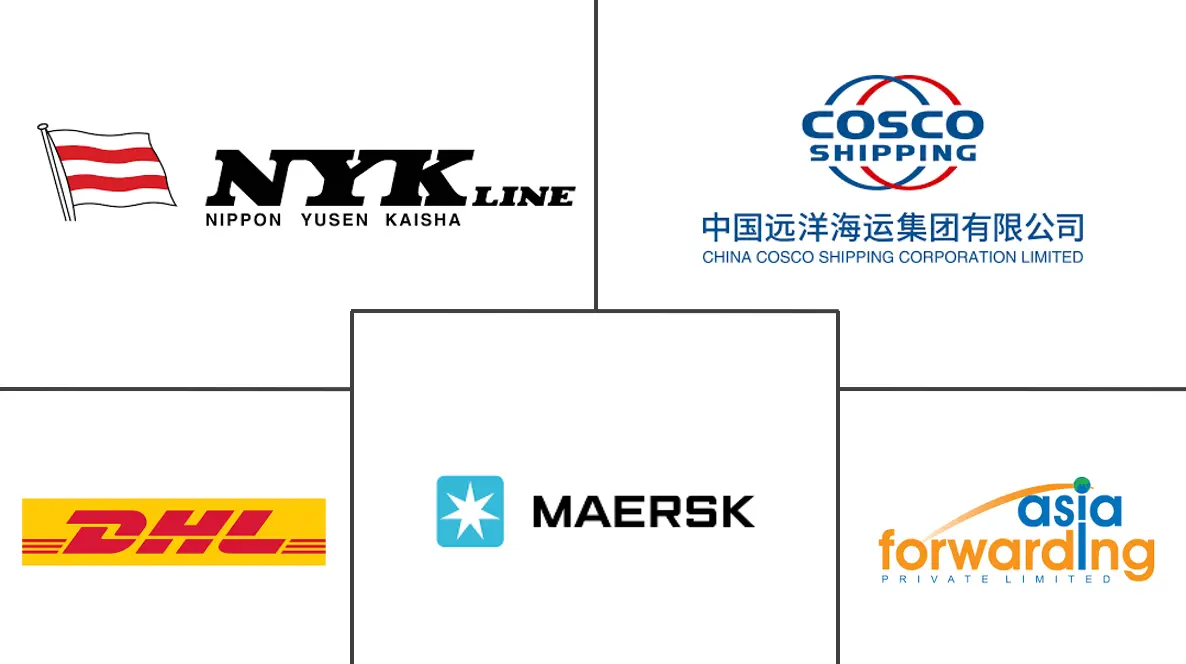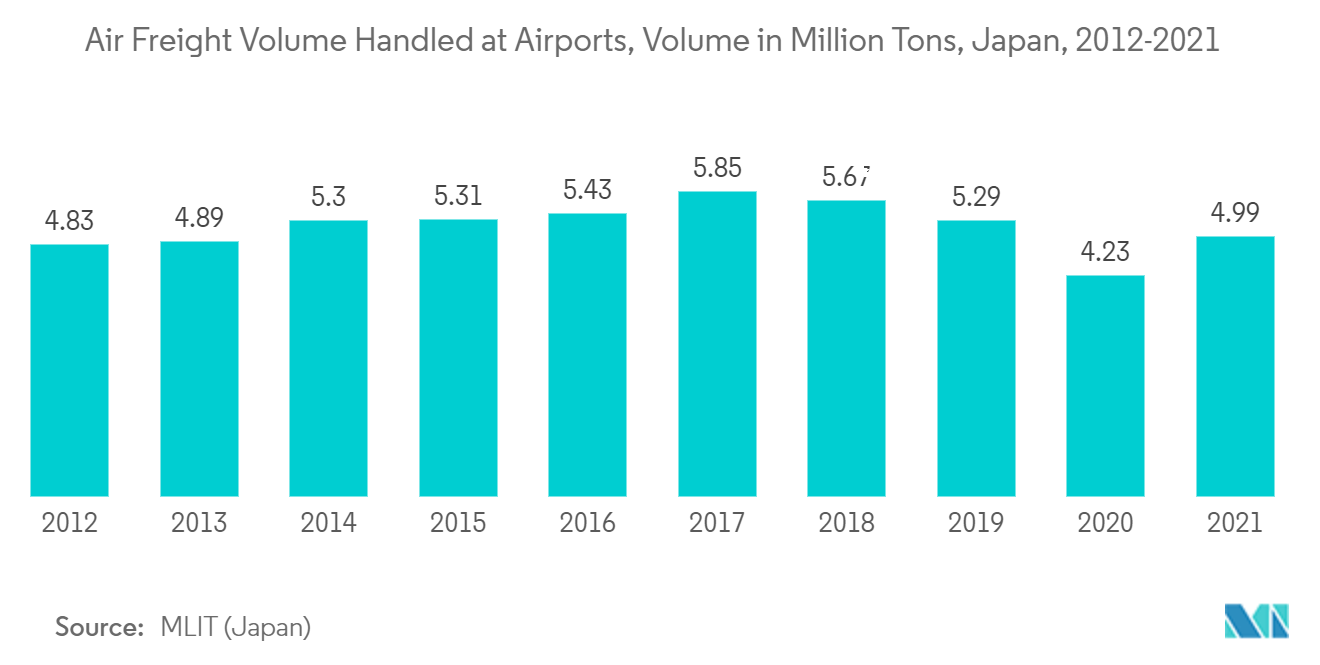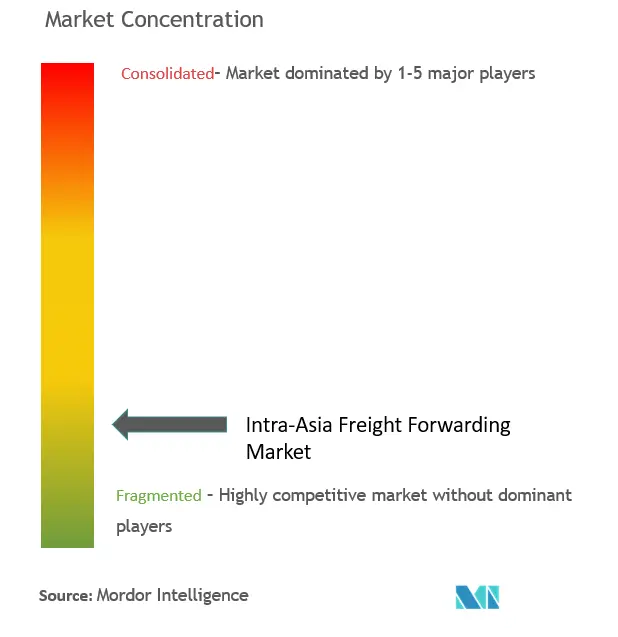Intra-Asia Freight Forwarding Market Size

| Study Period | 2019 - 2029 |
| Base Year For Estimation | 2023 |
| Forecast Data Period | 2024 - 2029 |
| Historical Data Period | 2019 - 2022 |
| CAGR | 5.00 % |
| Market Concentration | Low |
Major Players
*Disclaimer: Major Players sorted in no particular order |
Intra-Asia Freight Forwarding Market Analysis
Over the next few years, the intra-Asia freight forwarding market is expected to register a CAGR of more than 5%.
- The COVID-19 pandemic led to global lockdowns, and commercial activities were halted, challenging the economy and disrupting the freight forwarding market with massive changes in operations, supply chains, regulations, and workforce requirements. Air and ocean freight volumes fell significantly in 2020; total ocean freight container volumes handled at Chinese ports dropped by 10.1% in the first few months of 2020. Later, as restrictions eased, cargo movement increased significantly across the region.
- Countries are also working on joint projects to boost cross-border trade. For example, in January 2023, the Indian Ministry of Road Transportation and Highways and the Japanese Delegation met to work on projects for digital transformation in the areas of intelligent transportation systems and eco-friendly mobility.The committee also planned to build roads between India and Japan so that people and goods could move more easily.
- In the meantime, Swissport, an aviation company, opened a new air cargo center at Central Japan International Airport in October 2022 to meet the growing demand for freight transport.
- Asia, on the other hand, is becoming a global logistics hub right now, and it is expected that the region will be responsible for about half of the world's trade growth by 2030. Also, more start-ups, mergers, and acquisitions brought more than USD 25 billion to Asia in the first quarter of 2021. So, the region's freight forwarders can expect a lot of business from the growing number of projects and trade activities.
Intra-Asia Freight Forwarding Market Trends
Booming E-commerce Sector is Driving the Market
In 2022, e-commerce in the Asia Pacific region witnessed significant growth, primarily driven by rapid urbanization, the growing middle class, the increasing penetration of digital payments, and the expansion of the e-commerce ecosystem. In addition, the pandemic outbreak also acted as a catalyst for accelerating online retail sales in the region. The growing e-commerce ecosystem requires freight and logistics support for the smooth movement of shipments.
Moreover, e-commerce growth is driving the retail industry toward omnichannel, and in 2021, the region remained the largest market for retail e-commerce, with digital sales amounting to more than USD 2.9 trillion, whereas these sales were three times greater than those in North America and nearly five times greater than those in Western Europe. In addition, in 2022, China will have outperformed the e-commerce market by a large margin.
Meanwhile, in 2022, fast-moving consumer goods (FMCG) e-commerce emerged as the second-biggest retail channel next to traditional trade, which accounted for more than 19% of sales in the region. However, as per industry experts' estimates, e-commerce accounts for nearly 30% of FMCG sales in South Korea (34%), and China (31%). Moreover, in 2022, China topped online spending in the region, followed by Indonesia and India. Thus, the growing e-commerce sales boost the systematic supply chain and logistics services to provide smooth end-to-end transfers of goods, further resulting in the expansion of the freight forwarding market.

Japan is Experiencing Significant Growth in the Market
Japan's freight forwarding business is growing quickly. This is mostly due to more trade activities like importing and exporting.In December 2022, exports from the country reached a growth rate of more than 17%, and imports reached nearly 41% when compared to the same period in the previous year. Also, Japan's total exports of goods were worth more than USD 750 billion in 2021, which was an increase of 18% from the year before.
Moreover, in 2021, the major export destinations of Japan will be China with an export share of nearly 21% (USD 160 billion), Korea with an export share of nearly 6.9% (USD 52 billion), and Hong Kong and Thailand with an export share of 4.6% and 4.3%, respectively. Also, China is one of the biggest importers, with a share of more than 24% (1875 billion USD). Australia and other Asian countries are also big importers.
Also, air cargo transportation is growing a lot in the country. This is mostly because trade is growing, there aren't enough truck drivers, port traffic is getting worse, etc. In 2021, Japan's Narita Airport, the country's largest airport for air freight, will handle more than 2.6 million tons of air cargo, an increase of 32% when compared to the previous year. In addition, in 2021, the volume of air freight handled at Japanese airports amounted to more than 4.99 million tons, which was up by 18% when compared to the previous year. So, the demand for freight forwarders in the country is likely to be driven by the growth of freight forwarding.

Intra-Asia Freight Forwarding Industry Overview
The intra-Asia freight forwarding market's landscape is fragmented by nature, with a mix of global, regional, and local players. Small- and medium-sized local players still serve the market with small fleets and storage spaces. As the freight forwarding market is growing steadily and there is abundant opportunity, the players need to embrace technologies, become more digitized, and increase the scale and efficiency of their operations. Having a strong network spanning the globe is important for companies. In addition, some of the major players in the market include Asia Forwarding Private Limited, DHL, UPS, NYK Line, etc.
Intra-Asia Freight Forwarding Market Leaders
-
Maersk
-
DHL
-
CHINA COSCO SHIPPING
-
NYK Line
-
Asia Forwarding Private Limited.
*Disclaimer: Major Players sorted in no particular order

Intra-Asia Freight Forwarding Market News
- November 2022: NYK Line (a Japanese shipping company) planned to order two LNG-fueled large coal carriers from Oshima Shipbuilding Co., Ltd., and the vessels are expected to be delivered in 2025. In addition, this ship order is part of a bulk carrier fleet development that is aimed at achieving net-zero greenhouse gas emissions in the NYK Group's oceangoing businesses by 2050.
- August 2022: DHL Express (a global logistics company) and Singapore Airlines (SIA) operated the first of five new Boeing 777 freighters under a crew and maintenance agreement signed in March. The features of the new cargo plane include a maximum capacity of 102 tons.
Intra-Asia Freight Forwarding Market Report - Table of Contents
1. INTRODUCTION
- 1.1 Study Deliverables
- 1.2 Study Assumptions
- 1.3 Scope of the Study
2. RESEARCH METHODOLOGY
- 2.1 Analysis Methodology
- 2.2 Research Phases
3. EXECUTIVE SUMMARY
4. MARKET INSIGHTS
- 4.1 Current Market Scenario
- 4.2 Value Chain / Supply Chain Analysis
- 4.3 Insights on Investment Scenarios
- 4.4 Insights on Government Regulations and Initiatives
- 4.5 Brief on Technology Development in Online Freight Forwarding and Digital Platforms
- 4.6 Digitalisation of Freight Forwarding Market
- 4.7 Overview on E-commerce Logistics and Freight Forwarding
- 4.8 Impact of COVID-19 on the Market
5. MARKET DYNAMICS
- 5.1 Drivers
- 5.2 Restraints
- 5.3 Opportunities
-
5.4 Industry Attractiveness - Porter's Five Forces Analysis
- 5.4.1 Bargaining Power of Suppliers
- 5.4.2 Bargaining Power of Consumers
- 5.4.3 Threat of New Entrants
- 5.4.4 Threat of Substitutes
- 5.4.5 Intensity of Competitive Rivalry
6. MARKET SEGMENTATION
-
6.1 By Mode of Transportation
- 6.1.1 Ocean Freight Forwarding
- 6.1.2 Air Freight Forwarding
- 6.1.3 Road Freight Forwarding
- 6.1.4 Rail Freight Forwarding
-
6.2 By Customer Type
- 6.2.1 Business to Business (B2B)
- 6.2.2 Business to Customer (B2C)
-
6.3 By Application
- 6.3.1 Industrial and Manufacturing
- 6.3.2 Retail
- 6.3.3 Healthcare
- 6.3.4 Oil And Gas
- 6.3.5 Food And Beverages
- 6.3.6 Other Applications
-
6.4 By Geography
- 6.4.1 China
- 6.4.2 Japan
- 6.4.3 South Korea
- 6.4.4 India
- 6.4.5 Rest of Asia
7. COMPETITIVE LANDSCAPE
- 7.1 Market Concentration Overview
-
7.2 Company Profiles
- 7.2.1 Maersk
- 7.2.2 DB Schenker
- 7.2.3 DHL
- 7.2.4 FedEx
- 7.2.5 CHINA COSCO SHIPPING
- 7.2.6 NYK Line
- 7.2.7 Yamato Transport Co., Ltd.
- 7.2.8 Hitachi Transport System, Ltd.
- 7.2.9 CEVA Logistics
- 7.2.10 Kuehne+Nagel
- 7.2.11 Asia Forwarding Private Limited.
- 7.2.12 XPO, Inc.
- 7.2.13 UPS*
- *List Not Exhaustive
8. FUTURE OF THE FREIGHT FORWARDING MARKET
9. APPENDIX
** Subject To AvailablityIntra-Asia Freight Forwarding Industry Segmentation
Freight forwarders are an important part of the supply chain. They act as middlemen between the company that ships the goods and the place where the goods will end up.It is the coordination and shipment of goods from one place to another via single or multiple carriers via air, marine, rail, or highway. The report provides a complete background analysis of the global freight forwarding market, which includes an assessment of the economy, a market overview, market size estimations for key segments, emerging trends in the market, market dynamics, and key company profiles. The report also covers the impact of COVID-19 on the market.
The Intra-Asia Freight Forwarding Market is segmented by mode of transport (air freight forwarding, ocean freight forwarding, road freight forwarding, and rail freight forwarding), by customer type (business-to-business (B2B)), by application (industrial and manufacturing, retail, healthcare, oil and gas, food and beverage, and other applications), and by geography (China, Japan, South Korea, India, and the Rest of Asia). The Intra-Asia Freight Forwarding Market report offers market size and forecast values (in USD billion) for all the above segments.
| By Mode of Transportation | Ocean Freight Forwarding |
| Air Freight Forwarding | |
| Road Freight Forwarding | |
| Rail Freight Forwarding | |
| By Customer Type | Business to Business (B2B) |
| Business to Customer (B2C) | |
| By Application | Industrial and Manufacturing |
| Retail | |
| Healthcare | |
| Oil And Gas | |
| Food And Beverages | |
| Other Applications | |
| By Geography | China |
| Japan | |
| South Korea | |
| India | |
| Rest of Asia |
Intra-Asia Freight Forwarding Market Research FAQs
What is the current Intra-Asia Freight Forwarding Market size?
The Intra-Asia Freight Forwarding Market is projected to register a CAGR of greater than 5% during the forecast period (2024-2029)
Who are the key players in Intra-Asia Freight Forwarding Market?
Maersk, DHL, CHINA COSCO SHIPPING, NYK Line and Asia Forwarding Private Limited. are the major companies operating in the Intra-Asia Freight Forwarding Market.
What years does this Intra-Asia Freight Forwarding Market cover?
The report covers the Intra-Asia Freight Forwarding Market historical market size for years: 2019, 2020, 2021, 2022 and 2023. The report also forecasts the Intra-Asia Freight Forwarding Market size for years: 2024, 2025, 2026, 2027, 2028 and 2029.
Intra-Asia Freight Forwarding Industry Report
Statistics for the 2024 Intra-Asia Freight Forwarding market share, size and revenue growth rate, created by Mordor Intelligence™ Industry Reports. Intra-Asia Freight Forwarding analysis includes a market forecast outlook to 2029 and historical overview. Get a sample of this industry analysis as a free report PDF download.



